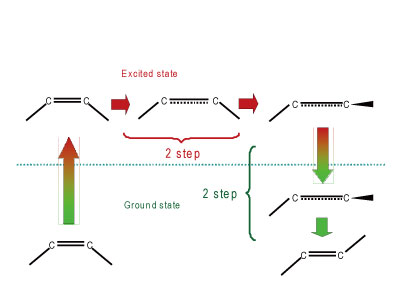石田 俊正(いしだ としまさ)
Toshimasa ISHIDA
l Research
l 講義資料
l CV etc.
|
Office |
Room 205, Fukui Institute for Fundamental Chemistry, Kyoto University
|
|
Phone/Fax |
+81-75-711-7838
|
|
Email |
ishida@fukui.kyoto-u.ac.jp
|
|
Research Area |
Computational Chemistry/Theoretical Chemistry
|
|
Research Interest |
Molecular Photochemistry, Reactions of biomolecules, Generation of potential energy surfaces
|
|
Keywords |
Molecular Photochemistry, Reactions of biomolecules, PES, Non-adiabatic transition
|
|
Education |
Graduated from Graduate School of Science, The University of Tokyo
|
|
Degree |
Doctor of Science, The University of Tokyo
|
|
Work Experience |
Apr. 1989 Research Associate, Faculty of Arts and Sciences, Shizuoka University Apr. 1995 Associate Professor, Faculty of Arts and Sciences, Shizuoka University Oct. 1995 Associate Professor, Faculty of Engineering, Shizuoka University Apr. 2002 Associate Professor, Institute for Molecular Science Apr. 2004 Associate Professor, Faculty of Engineering, Shizuoka University Oct. 2004 Associate Professor, General Division, Fukui Institute for Fundamental Chemsitry, Kyoto University
|
|
|
Apr. 1996 to Mar. 1997 Long-term Researcher Abroad (Ministry of Education Culture, Sports, Science and Technology Japan) at Department of Chemistry, Northwestern University with Prof. George C. Schatz
|
|
Membership |
The Chemical Society of Japan Japan Society of Molecular Science Society of Computer Chemistry, Japan American Physical Society |
l
略歴他
|
居室 |
福井謙一記念研究センター205
|
|
電話・FAX |
075-711-7838
|
|
電子メールアドレス |
ishida@fukui.kyoto-u.ac.jp
|
|
【研究分野】 |
計算化学・理論化学
|
|
【現在の研究課題】 |
光機能分子・生体分子の反応・ポテンシャル面生成法
|
|
【研究内容キーワード】 |
光機能分子・生体分子・ポテンシャル面・非断熱遷移
|
|
【学歴】 |
1989年3月東京大学理学系大学院相関理化学専攻博士課程修了
|
|
【学位】 |
1989年3月理学博士(東京大学)
|
|
【略歴】 |
1989年4月 静岡大学教養部助手 1995年4月静岡大学教養部助教授 1995年10月静岡大学工学部助教授 2002年4月岡崎国立共同研究機構分子科学研究所助教授(流動部門) 2004年4月静岡大学工学部助教授 2004年10月京都大学福井謙一記念研究センター助教授 2007年4月同准教授
|
|
|
1996年4月-1997年3月 米国Northwestern大学化学(George C. Schatz教授)(文部省在外研究員(若手)
|
|
【所属学会】 |
日本化学会 日本分子科学会 日本コンピュータ化学会 米国物理学会 |
l
Research
 We are interested in reactions in the excited state induced by
photons. One example
is retinal.
We are interested in reactions in the excited state induced by
photons. One example
is retinal.
Retinal is embedded in Rhodopsin protein, which is responsible for
vision of vertebrate animals including human. When the retinal is exposed to
light, the 11-cis form is excited and isomerized to the all-trans one. This
process has been investigated experimentally as well as theoretically.
We carried out on-the fly classical dynamics calculations combined
with ab initio quantum chemical
computations. The 9-cis form product in addition to the all-trans one is
generated in the present gas-phase calculation for the 12p model, despite that the 9-cis generation is suppressed in
protein. We have found that energy relaxation on the ground state occurs in two
steps in the 12p model. In
the first step a metastable intermediate state is formed at ~100fs after
photoexcitation at the energy around 20~40kcal/mol down from the excited
potential energy surface, then it further relaxes to the energy around
60~80kcal/mol from the excited surface, leading to the final state (second
step). This relaxation pattern can be seen in all the three pathways to the
all-trans, 9-cis and (reverted) 11-cis form. Fourier transformation analysis
reveals that the effective vibrational frequencies of the intermediate state
are 1,600-2000 cm-1, which can be attributed to the conjugate CC
bond frequencies in the electronically ground state. The two step relaxation
may be due to dynamical barriers. The two step relaxation is not revealed in
the smaller 6p model. The
branching ratio is about 1:1:2 for the all-trans, 9-cis, and 11-cis form
generation.
We also performed reaction simulation for 9-cis retinal. We have
found that the
reaction time for 9-cis retinal is slower than 11-cis analogue and that the quantum
yield is smaller, which is in agreement with experiments. This is due to the
trajectory trapping in an energy barrier in the excited state.
We plan to carry out simulations of retina molecules with protein
environment, that is, Rhodopsin and Isorhodopsin.